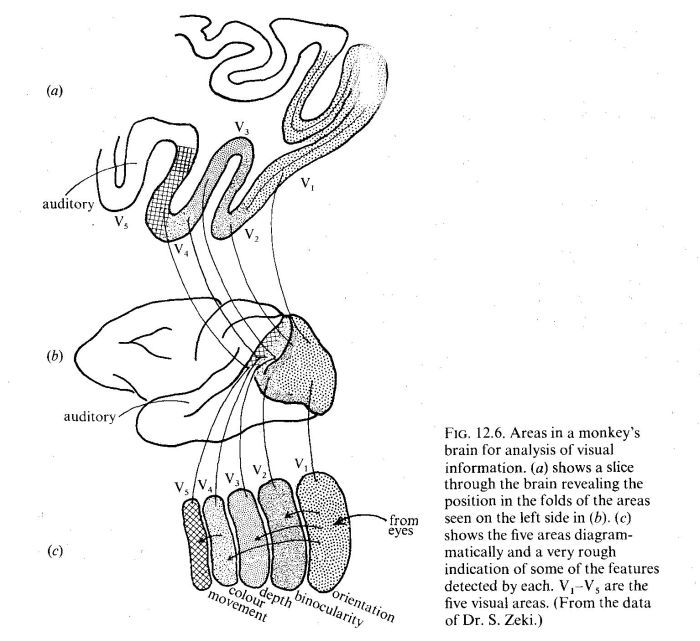

The brain pursues ongoing programs of search for information that will meet the needs represented by its motivational centres. At each level through the brain the visual information is packaged into larger and larger units. First by computing in the retina, which produces nerve impulses in the optic nerve each carrying a small amount of information, as it were the letters of the visual code. The cells of the thalamus (lateral geniculate body) send on information about the distribution of small circular spots of light or dark, rather like the dots on a photograph that has been screened for reproduction in a newspaper. Then the primary visual cortex uses these spots to compute edges, which could be compared with words. Further on both in space through the cortex and in time, the brain interprets a whole 'sentence'-say the sight of a cup or a face, or a letter, word, or larger unit of information that is picked out in reading, perhaps a whole line of print. The process does not continue uninterruptedly for vision, or any other sense. The whole set of brain actions goes on in discrete packages, each of perhaps one-fifth of a second. These may be mainly visual, or mainly auditory, with perhaps mixtures of items from visceral or emotional sources, or of memory records from previous experience. Our own awareness of the stream of consciousness suggests that there is some central processor receiving information at about this rate, which is also the order of frequency of the electroencephalogram.
So each part of the system progressively extracts more and more abstract or general features of the visual information. It combines them with information from other sense organs and of course with the stored information and instructions already in it. Each part from time to time gives outputs producing appropriate actions in the further regions to which it is connected. We are only just beginning to find the details of this web of backward and forward connections. There is some evidence that each of the successive visual areas has its own connections with the thalamus (Diamond 1978).
At present there is no adequate theory as to how the information collected in the various cortical areas interacts to produce actions by the whole animal or man. Some people have supposed that at later stages the process of decoding and re-coding must produce the activation of cells each representing some complex feature of the world. Thus Gross of Princeton believes that he has found cells in the monkey's cortex that respond only when the animal sees a monkey's hand (1972). They do not even respond to a human hand. Such hypothetical cells for recognizing complicated features have been called 'gnostic neurons' or, humorously, 'grandmother's-face cells'. But other people have given different interpretations of Gross's observations. The fact is that there is no agreed hypothesis as to how the signals from the various feature-detector cells interact to constitute complete messages. It can hardly be that there are gnostic neurons representing all the various features of the world as seen from every angle. It is much more likely that the 'putting together' of all the information is a property of groups of neurons. Anyhow it is a mistake to try to discover some 'final' stage of synthesis. Each part of the brain continually moves on from one action to another, just as the whole person does in real life.
Programs of the brain.
J. Z. Young 1978
http://www.amazon.co.uk/exec/obidos/ASIN/0198575459/